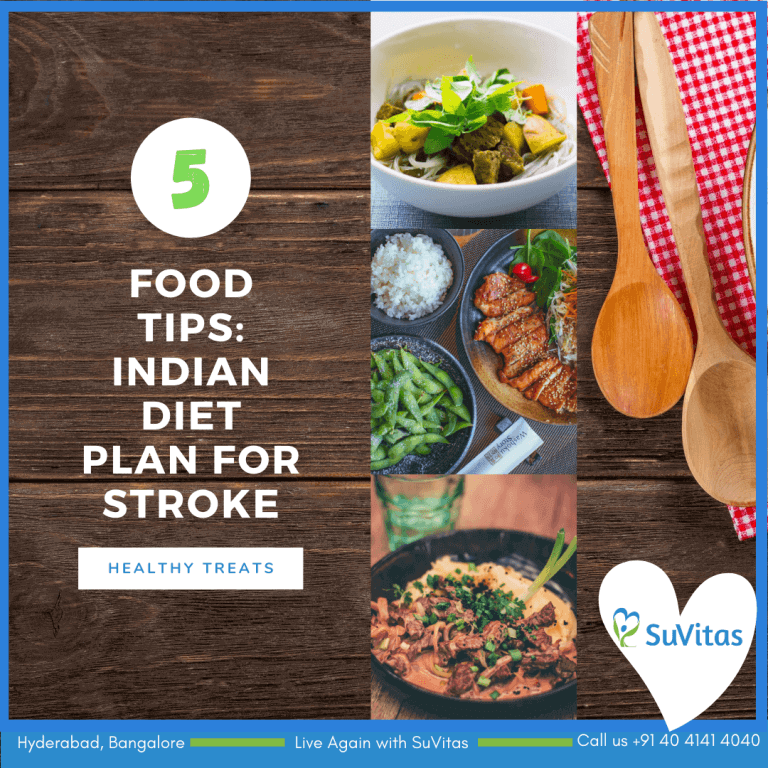Reviewed by: Dr. Aastik Bhatt, Physical Medicine & Rehabilitation Specialist, HCAH SuVitas
Last Updated: Sep 12, 2025
Why Diet Matters After a Stroke
After a stroke, what you eat directly impacts your recovery, energy, and risk of another stroke. Research shows that many stroke survivors in India rely heavily on refined carbs (white rice, bread, noodles) and processed foods (pickles, packaged juices, fried snacks). These dietary patterns increase the risk of high blood pressure, diabetes, and cholesterol – all major triggers for stroke.
On the other hand, maintaining a balanced Indian diet with whole grains, lean proteins, fruits, vegetables, and heart-friendly fats can help improve brain health, control blood pressure, and support long-term recovery.
Foods to Include After Stroke
✔️ Whole grains – Brown rice, oats, whole wheat chapati, barley, millet (ragi, jowar, bajra)
✔️ Fruits & vegetables – At least 5 servings daily; choose colorful options like spinach, carrots, tomatoes, apples, and oranges
✔️ Healthy proteins – Lentils, beans, paneer, tofu, fish, eggs, lean chicken
✔️ Good fats – Nuts, seeds, olive oil, flaxseed, sunflower seeds, walnuts (rich in Omega-3)
✔️ Low-fat dairy – Skim milk, curd, buttermilk
Foods to Avoid After Stroke
❌ Refined carbs – White rice, white bread, bakery products
❌ Processed & fried foods – Chips, pakoras, fast food
❌ High-sodium foods – Pickles, papads, packaged soups, instant noodles
❌ Red & processed meats – Mutton, sausages, bacon
❌ Sugary drinks – Packaged juices, aerated sodas
5 Expert Tips to Plan an Indian Diet for Stroke Survivors
- Go Responsible With Carbs
Pick whole grains over refined carbs. Brown rice, multigrain chapatis, oats, and millets provide fiber that reduces cholesterol and improves gut health.
- Practice Moderation
Fill your plate with variety — grains, proteins, vegetables, fruits, and dairy. Aim for at least 5 servings of fruits and vegetables every day.
- Choose Healthy Dressings
A salad can be ruined by heavy mayo or fried toppings. Use olive oil, lemon juice, apple cider vinegar, or low-fat curd for dressings.
- Reduce Sodium, Not Just Salt
Most packaged foods contain hidden sodium. Check food labels and avoid canned soups, sauces, and frozen meals. Stick to ≤1500 mg sodium per day.
- Stock Up on Stroke-Preventing Nutrients
Add foods rich in potassium (bananas, spinach), Omega-3 (flaxseeds, fish), Vitamin B3 (nuts, poultry), Lycopene (tomatoes, watermelon) and CoQ10 (oily fish, nuts).
Sample Indian Diet Plan for Stroke Survivors
- Early Morning
- 1 glass lime water
- Handful of roasted flax seeds/sunflower seeds
Breakfast
- Mixed vegetable oats upma / vegetable poha with peanuts
- 1 cup sugar-free coffee or green tea with low-fat milk
Mid-Morning Snack
- 1 apple/banana/orange/watermelon
- 1 cup green tea
Lunch
- 1 cup brown rice or 2 chapatis (multigrain)
- 1 bowl boiled/steamed vegetables
- 1 bowl beetroot raita with low-fat curd
- 1 dal serving (lentils)
Evening Snack
- 1 fruit chaat or sprouts salad
- 1 cup herbal tea
Dinner
- 2 whole wheat chapatis
- 1 bowl paneer curry (low-oil) or grilled fish (if non-veg)
- 1 bowl cucumber/tomato salad
💡 Tip: Avoid late-night heavy meals. Finish dinner at least 2 hours before bedtime.
Quick Recovery Tips
- Stay hydrated: Drink 8–10 glasses of water daily.
- Use heart-friendly oils: Mustard oil, olive oil, or groundnut oil in moderation.
- Cook smart: Prefer steaming, boiling, and grilling instead of frying.
- Portion control: Use a smaller plate to avoid overeating.
FAQs on Stroke Diet in India
- Can stroke patients eat rice?
Yes, but choose brown rice, red rice, or millets instead of polished white rice to control sugar and cholesterol levels. - Which fruits are best for stroke recovery?
Bananas, oranges, apples, watermelon, and tomatoes (rich in potassium and antioxidants). - Is milk good for stroke patients?
Yes, but prefer low-fat milk, curd, or buttermilk to avoid excess saturated fat. - What foods should stroke survivors strictly avoid?
Excess salt, fried snacks, red meat, bakery products, and sweetened beverages. - Can a vegetarian Indian diet support stroke recovery?
Absolutely. A mix of whole grains, legumes, nuts, seeds, dairy, and fresh vegetables provides all essential nutrients.
Final Word
Healthy food choices are not just preventive but a powerful tool for recovery after a stroke. Whether your goal is to prevent recurrence or to rebuild strength post-stroke, diet plays a central role.
For a personalized diet plan tailored to your health profile, connect with our HCAH SuVitas dietitian team today.

